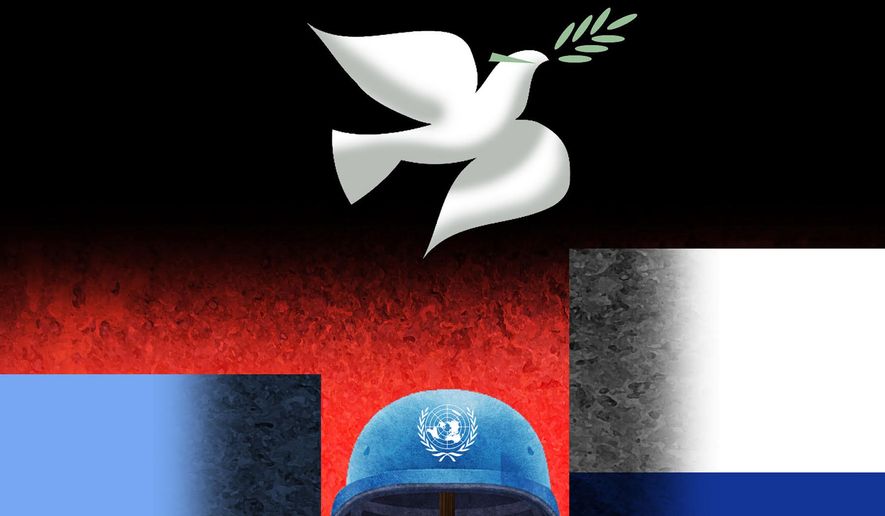OPINION:
Some may think it is premature to pursue peace in Ukraine following Russian President Vladimir Putin’s invasion of that country. He failed to calculate President Volodymyr Zelenskyy’s willingness to stand and fight. Nor did President Biden envision Mr. Zelenskyy’s stalwart stance in opposing Russia’s assault. Mr. Biden’s first instinct was to offer Mr. Zelenskyy exile. Since then, Mr. Biden has learned about resolve, while Mr. Putin has learned little.
The Russian dictator continues to wage his war against a recalcitrant foe that has been much assisted by the U.S. and NATO. The deadly HIMARS rocket launchers, Stinger air defense missiles, and Javelin anti-tank warheads the U.S. provided are but a few of the systems that have given Ukraine a fighting chance against the Russian juggernaut. Recent Ukrainian counteroffensive successes using U.S. and NATO weapons have shown that Ukraine’s military can fight and win if the West continues to provide the right arms and munitions.
Hopefully, the Russian people — even without Mr. Putin’s concurrence — will see that the war in Ukraine has been devastating for them. Russian casualties are approaching 80,000, a stunning cost in just nine months. Russian men are fleeing to other states to avoid being pressed into service by Mr. Putin while increasing protests inside Russia confirm the war’s rising unpopularity there. And if Mr. Putin decides to escalate the fight with tactical nuclear weapons, it may well herald his end. The West will be compelled to respond. Indeed, one wonders if his military — which is being chewed up in combat and thus increasingly leery of Mr. Putin — will comply, even if so ordered.
All of this does not augur well for peace. There is much fighting ahead, and until the situation is ripe, peace will be elusive. Yet that ripeness will inevitably materialize. When it does, the U.S. and NATO need to acknowledge it. Mr. Zelenskyy has been clear that he will not stop fighting until Russia is ejected from Ukraine, including Crimea, which Moscow wrongly seized in 2014. It is hard to envision that level of success, barring a total collapse of Russian fortunes — although Mr. Putin could be removed from power, thereby hastening an unclouded Ukrainian victory. After all, there are many options in Russia for “disappearing” him.
Nonetheless, indications of peace could emerge after a substantial liberation of Ukrainian territory is achieved, either by Ukrainian counteroffensives or Russian withdrawals. What should the West do when that situation presents itself?
First, it is important to quietly discuss and gauge Mr. Zelenskyy’s willingness to recognize victory when it is at hand. That means if Ukraine reestablishes its pre-conflict lines, then he has indeed achieved a significant victory in defeating Russia’s effort to bring down his government.
Second, the West, including Ukraine, must come to recognize that an unambiguous resolution to the war is unlikely. Yet Russia will be looking for ways to save face as it untangles itself from a conflict that has sapped its strength and sullied its image on the world stage.
Finally, it’s in NATO’s best interest to cut a suitable firebreak between the warring parties to ensure that the embers of passion do not reignite more wildfires. Put another way, the initial steps to peace require all sides — combatants and Ukraine’s supporters — to agree that the opportunity for peace is worth the risk. That risk is the configuration of a peacekeeping force in Ukraine that will help the combatants disengage after an agreed-upon truce.
There are both good and bad examples of how to configure that peacekeeping force. The United Nations Interim Force in Lebanon (UNIFIL) was a bad example. Its mandate was weak, its force poorly prepared, and the combatants — primarily Israel and the Palestine Liberation Organization — did not support it. Just to the southeast of UNIFIL, however, was the United Nations Disengagement Observer Force (UNDOF) that separated Israeli and Syrian forces following the 1973 Yom Kippur War. UNDOF was conceived by U.S. diplomacy in 1974 and has worked for 48 years for one simple reason. It had the concurrence of both Israel and Syria as well as the imprimatur of their respective supporters, the U.S. and Russia. A lightly armed international force, UNDOF — supported by unarmed peace observers like those found in the United Nations Truce Supervision Organization (UNTSO) — provided both time and space as a trusted agent between warring parties. The U.S. provided legitimacy to UNDOF, but not soldiers. A similar effort could help Ukraine.
But there’s a proviso. The effete U.N. should have no part in configuring that force. Rather, the U.S. and its allies should thoughtfully assemble it from both NATO countries and those acceptable to Ukraine and Russia. The U.S. wisely conceived and advanced the framework of UNDOF. Now is the time to dust off the American-led shuttle diplomacy that shaped and produced it.
• L. Scott Lingamfelter is a retired U.S. Army colonel and author of “Desert Redleg: Artillery Warfare in the First Gulf War” (University Press of Kentucky). His new book, “Yanks in Blue Berets: American UN Peacekeepers in the Middle East,” will be released by UPK on July 4, 2023.




Please read our comment policy before commenting.